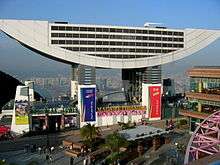Peak Tower
| Peak Tower | |
|---|---|
| 凌霄閣 | |
 Peak Tower viewed from Lugard Road. | |
| General information | |
| Status | Complete |
| Type |
Tram station, tourist attraction |
| Architectural style | Postmodern |
| Location | Victoria Gap, Hong Kong |
| Elevation | 396 metres (1,299 ft) |
| Construction started | 1993 |
| Opened | 1997 |
| Renovated | 2006 |
| Cost | HK$500 million |
| Renovation cost | HK$100 million |
| Technical details | |
| Floor count | 8 |
| Floor area | 10,400 square metres (112,000 sq ft) |
| Design and construction | |
| Architect | TFP Farrells |
| Developer | Hongkong and Shanghai Hotels |
| Engineer | Arup |
| Main contractor | Chun Wo |
| Renovating team | |
| Architect | Ronald Lu and Partners |
| Engineer | Arup |
| Main contractor | Hip Hing Construction |
| Website | |
|
www | |
| References | |
| [1][2][3][4] | |
The Peak Tower (Chinese: 凌霄閣) is a leisure and shopping complex located at Victoria Gap, near the summit of Victoria Peak on Hong Kong Island, Hong Kong. It also houses the upper terminal of the Peak Tram. Both the Peak Tower and the Peak Tram are owned by the Hong Kong and Shanghai Hotels group, the owner of Hong Kong's famous Peninsula Hotel along with many other properties. The tower and tram are jointly promoted by the collective branding known as The Peak.[5][6]
The Peak Tower is located at an elevation of 396 m, 156 m below the summit of Victoria Peak. Because the architects sought a design which would be prominent on the skyline but would not interrupt the natural line of the hills, they chose a site in a dip along the line of the hills, and restricted the tower's height to 428 m above sea level.[7]
History

In 1881, Alexander Findlay Smith, who owned a hotel on the Peak, petitioned for the right to introduce a funicular railway to Hong Kong.[8] It took three years to build, as much of the heavy equipment and rails had to be hauled uphill by the workers, who had no mechanical support. A simple wooden structure was built for the first terminal.[8] The Peak Tram was opened for public service on 28 May 1888 by the then Governor Sir George William des Voeux.[8]
Architecture
The current Peak Tower is the second on the site. Construction of the first one started in 1960, and it was opened on 29 August 1969. The Tower Restaurant was situated on the top deck while the Peak Coffee Shop was located on the floor below. Both the upper floors were supported by two columns allowing a clear space between the upper and lower parts of the tower. This design feature has been retained in the redeveloped tower, but with quite a different shape to the upper section.[7] The first tower was demolished in 1993 and a groundbreaking ceremony on the new tower was held later the same year.[9][10]
The current Peak Tower was the work of the British architect Terry Farrell, and was completed in 1997. It has seven floors with a total area of 10,400 m² (112,000 ft²) with a wok shape at the top. A viewing platform located on the third floor overlooks Victoria Harbour.
The building was altered from 2005-2006 at a cost of $100 million.[11] The lower portion was glassed in to increase retail space, and the escalators were relocated. The Peak Tower now has eight floors with the viewing terrace relocated to the top of the building (at the top of the 'wok' shape) that overlooks both Victoria Harbour and Aberdeen (SW of the Hong Kong Island); however, severe air pollution often hinders the outlook from this venue.
Attractions
Apart from the Peak Tram terminal, viewing terrace, and gift shops, the tower also included several attractions: Ripley's Believe It or Not! Odditorium, Hong Kong's Historical Adventure (a journey through scenes of the Hong Kong's early history, and the first computer-operated entertainment ride in Hong Kong) and the Peak Explorer Motion Simulator.
In 2000, after the closure of Hong Kong's Historical Adventure, Madame Tussauds Hong Kong moved in to occupy the former vacated premises to become the first Madame Tussaud's permanent outlet in the Asia-Pacific region.
The Peak Tower is located close to a second leisure and shopping centre, the Peak Galleria, built atop the bus station used by the public buses and green minibuses that serve the Peak.
References
- ↑ "Peak Tower". Farrells. Retrieved 16 April 2015.
- ↑ Wong, Raymond, Wai Man. "15 Most Outstanding projects in Hong Kong". City University of Hong Kong. Retrieved 16 April 2015.
- ↑ "Peak Tower Revitalisation, Hong Kong". Ronald Lu and Partners. Retrieved 16 April 2015.
- ↑ "The Peak Tower Revitalisation". Member projects. Hong Kong Construction Association. Retrieved 16 April 2015.
- ↑ "The Hongkong and Shanghai Hotels - Peak Tower". The Hongkong and Shanghai Hotels, Limited. Retrieved 13 March 2007.
- ↑ "The Peak". The Peak. Archived from the original on 6 March 2007. Retrieved 13 March 2007.
- 1 2 "Peak Tower History". The Peak. Archived from the original on 20 February 2007. Retrieved 13 March 2007.
- 1 2 3 Cavaliero, Eric (24 July 1997). "Grand old lady to turn 110". The Standard.
- ↑ Torode, Greg (1 July 1993). "Wreckers move in on Peak Tower". South China Morning Post.
- ↑ "Work starts on new Peak Tower". South China Morning Post. 11 November 1993. p. 8.
- ↑ Tsang, Denise (5 July 2006). "Wrapping to come off Peak Tower after $100m renovation". South China Morning Post.
External links
| Wikimedia Commons has media related to Peak Tower. |
Coordinates: 22°16′17.49″N 114°8′59.45″E / 22.2715250°N 114.1498472°E